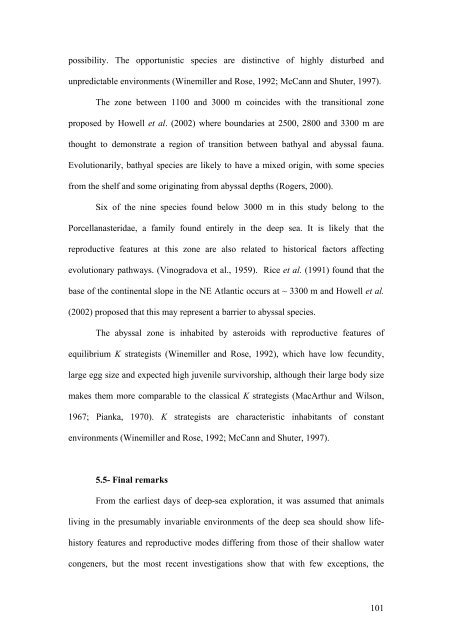Download (3398Kb) - ePrints Soton - University of Southampton
Download (3398Kb) - ePrints Soton - University of Southampton
Download (3398Kb) - ePrints Soton - University of Southampton
You also want an ePaper? Increase the reach of your titles
YUMPU automatically turns print PDFs into web optimized ePapers that Google loves.
possibility. The opportunistic species are distinctive <strong>of</strong> highly disturbed and<br />
unpredictable environments (Winemiller and Rose, 1992; McCann and Shuter, 1997).<br />
The zone between 1100 and 3000 m coincides with the transitional zone<br />
proposed by Howell et al. (2002) where boundaries at 2500, 2800 and 3300 m are<br />
thought to demonstrate a region <strong>of</strong> transition between bathyal and abyssal fauna.<br />
Evolutionarily, bathyal species are likely to have a mixed origin, with some species<br />
from the shelf and some originating from abyssal depths (Rogers, 2000).<br />
Six <strong>of</strong> the nine species found below 3000 m in this study belong to the<br />
Porcellanasteridae, a family found entirely in the deep sea. It is likely that the<br />
reproductive features at this zone are also related to historical factors affecting<br />
evolutionary pathways. (Vinogradova et al., 1959). Rice et al. (1991) found that the<br />
base <strong>of</strong> the continental slope in the NE Atlantic occurs at ~ 3300 m and Howell et al.<br />
(2002) proposed that this may represent a barrier to abyssal species.<br />
The abyssal zone is inhabited by asteroids with reproductive features <strong>of</strong><br />
equilibrium K strategists (Winemiller and Rose, 1992), which have low fecundity,<br />
large egg size and expected high juvenile survivorship, although their large body size<br />
makes them more comparable to the classical K strategists (MacArthur and Wilson,<br />
1967; Pianka, 1970). K strategists are characteristic inhabitants <strong>of</strong> constant<br />
environments (Winemiller and Rose, 1992; McCann and Shuter, 1997).<br />
5.5- Final remarks<br />
From the earliest days <strong>of</strong> deep-sea exploration, it was assumed that animals<br />
living in the presumably invariable environments <strong>of</strong> the deep sea should show lifehistory<br />
features and reproductive modes differing from those <strong>of</strong> their shallow water<br />
congeners, but the most recent investigations show that with few exceptions, the<br />
101
















